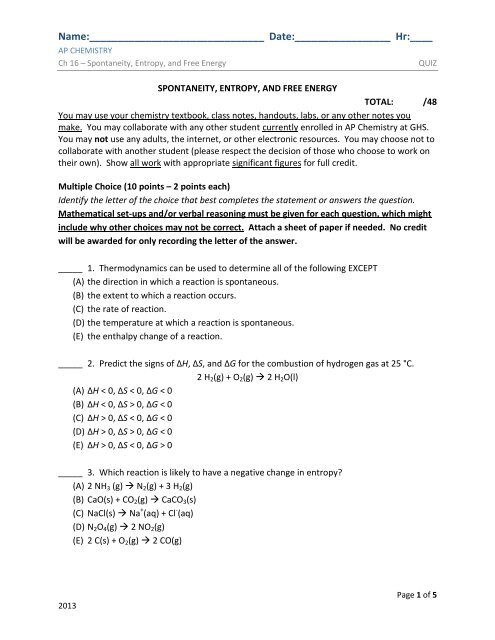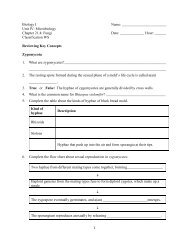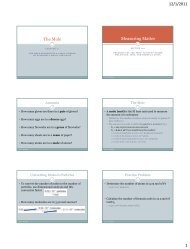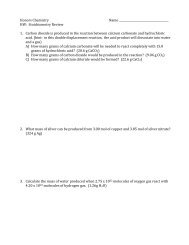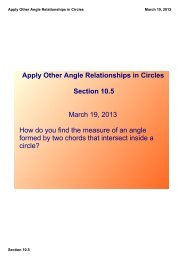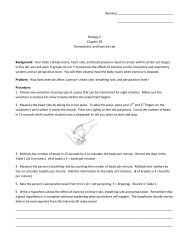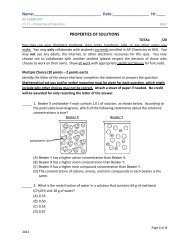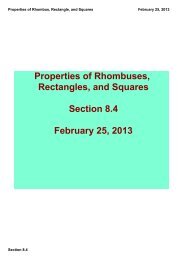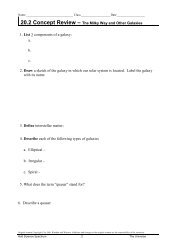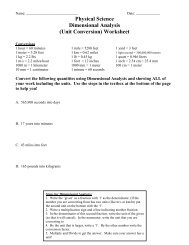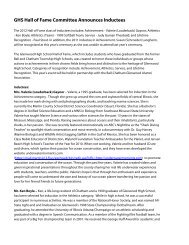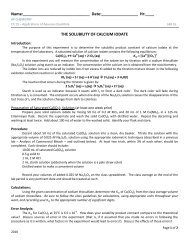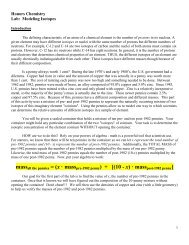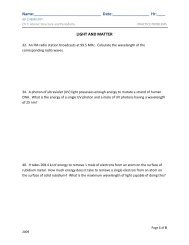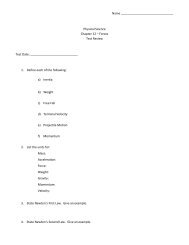Ch 16 QUIZ - AP Chemistry
Ch 16 QUIZ - AP Chemistry
Ch 16 QUIZ - AP Chemistry
You also want an ePaper? Increase the reach of your titles
YUMPU automatically turns print PDFs into web optimized ePapers that Google loves.
Name:_______________________________ Date:_________________ Hr:____<br />
<strong>AP</strong> CHEMISTRY<br />
<strong>Ch</strong> <strong>16</strong> – Spontaneity, Entropy, and Free Energy<br />
SPONTANEITY, ENTROPY, AND FREE ENERGY<br />
TOTAL: /48<br />
You may use your chemistry textbook, class notes, handouts, labs, or any other notes you<br />
make. You may collaborate with any other student currently enrolled in <strong>AP</strong> <strong>Ch</strong>emistry at GHS.<br />
You may not use any adults, the internet, or other electronic resources. You may choose not to<br />
collaborate with another student (please respect the decision of those who choose to work on<br />
their own). Show all work with appropriate significant figures for full credit.<br />
Multiple <strong>Ch</strong>oice (10 points – 2 points each)<br />
Identify the letter of the choice that best completes the statement or answers the question.<br />
Mathematical set-ups and/or verbal reasoning must be given for each question, which might<br />
include why other choices may not be correct. Attach a sheet of paper if needed. No credit<br />
will be awarded for only recording the letter of the answer.<br />
<strong>QUIZ</strong><br />
_____ 1. Thermodynamics can be used to determine all of the following EXCEPT<br />
(A) the direction in which a reaction is spontaneous.<br />
(B) the extent to which a reaction occurs.<br />
(C) the rate of reaction.<br />
(D) the temperature at which a reaction is spontaneous.<br />
(E) the enthalpy change of a reaction.<br />
_____ 2. Predict the signs of ∆H, ∆S, and ∆G for the combustion of hydrogen gas at 25 °C.<br />
2 H 2 (g) + O 2 (g) 2 H 2 O(l)<br />
(A) ∆H < 0, ∆S < 0, ∆G < 0<br />
(B) ∆H < 0, ∆S > 0, ∆G < 0<br />
(C) ∆H > 0, ∆S < 0, ∆G < 0<br />
(D) ∆H > 0, ∆S > 0, ∆G < 0<br />
(E) ∆H > 0, ∆S < 0, ∆G > 0<br />
_____ 3. Which reaction is likely to have a negative change in entropy<br />
(A) 2 NH 3 (g) N 2 (g) + 3 H 2 (g)<br />
(B) CaO(s) + CO 2 (g) CaCO 3 (s)<br />
(C) NaCl(s) Na + (aq) + Cl - (aq)<br />
(D) N 2 O 4 (g) 2 NO 2 (g)<br />
(E) 2 C(s) + O 2 (g) 2 CO(g)<br />
2013<br />
Page 1 of 5
Name:_______________________________ Date:_________________ Hr:____<br />
<strong>AP</strong> CHEMISTRY<br />
<strong>Ch</strong> <strong>16</strong> – Spontaneity, Entropy, and Free Energy<br />
<strong>QUIZ</strong><br />
_____ 4. Diluting concentrated sulfuric acid with water can be dangerous because the<br />
temperature of the solution can increase rapidly. What are the signs of ∆H, ∆S, and ∆G for this<br />
process<br />
(A) ∆H < 0, ∆S < 0, ∆G < 0<br />
(B) ∆H > 0, ∆S < 0, ∆G < 0<br />
(C) ∆H < 0, ∆S > 0, ∆G < 0<br />
(D) ∆H > 0, ∆S > 0, ∆G < 0<br />
(E) ∆H > 0, ∆S < 0, ∆G > 0<br />
_____ 5. For a chemical system, ∆G° and ∆G are equal when<br />
(A) the equilibrium constant, K, equals 1.<br />
(B) the equilibrium constant, K, equals 0.<br />
(C) the system is at equilibrium.<br />
(D) The reactants and products are in the gas phase.<br />
(E) the reactants and products are in their standard states.<br />
<strong>QUIZ</strong> IS CONTINUED ON THE NEXT PAGE<br />
2013<br />
Page 2 of 5
Name:_______________________________ Date:_________________ Hr:____<br />
<strong>AP</strong> CHEMISTRY<br />
<strong>Ch</strong> <strong>16</strong> – Spontaneity, Entropy, and Free Energy<br />
<strong>QUIZ</strong><br />
Free Response (38 points)<br />
Show all work with appropriate significant figures for full credit.<br />
6. (8 points) Cells use the hydrolysis of adenosine triphosphate, abbreviated as ATP, as a<br />
source of energy. Symbolically, this reaction can be written as<br />
ATP(aq) + H 2 O(l) ADP(aq) + H 2 PO 4 - (aq)<br />
where ADP represents adenosine diphosphate. For this reaction, ∆G° = -30.5 kJ.<br />
(a) Calculate K at 25°C.<br />
One reaction that occurs in human metabolism is<br />
(aq) + NH 3 (aq) ↔ (aq) + H 2 O(l)<br />
glutamic acid<br />
glutamine<br />
(b) For this reaction, ∆G° = +14.0 kJ. Calculate K at 25°C.<br />
(c) In a living cell this reaction is coupled with the hydrolysis of ATP. Calculate ∆G° and K at<br />
25°C for the following reaction:<br />
Glutamic acid(aq) + ATP(aq) + NH 3 (aq) ↔ Glutamine(aq) + ADP + H 2 PO 4 - (aq)<br />
(d) Does this reaction proceed spontaneously in the forward direction Justify your<br />
response.<br />
2013<br />
Page 3 of 5
Name:_______________________________ Date:_________________ Hr:____<br />
<strong>AP</strong> CHEMISTRY<br />
<strong>Ch</strong> <strong>16</strong> – Spontaneity, Entropy, and Free Energy<br />
<strong>QUIZ</strong><br />
7. (<strong>16</strong> points) Consider the following reaction at 25°C<br />
H 2 O(g) + Cl 2 O(g) ↔ 2 HOCl(g) K = 0.090<br />
For Cl 2 O(g): ∆G f ° = 97.9 kJ/mol; ∆H f ° = 80.3 kJ/mol; and S° = 266.1 J/K∙mol.<br />
(a) Calculate ∆G° for the reaction.<br />
(b) Use bond energy values (Table 8.4 in your text, p 351) to estimate<br />
∆H° for the reaction.<br />
(c) Use the results from parts (a) and (b) to determine a ∆S° for the reaction.<br />
(d) Determine values of ∆H f ° and S° for HOCl(g).<br />
(e) Determine a value for K for the overall reaction at 500. K.<br />
(f) Calculate ∆G at 25°C when P H2O = 18 torr, P Cl2O = 2.0 torr, and P HOCl = 30. torr.<br />
(g) Under the conditions in part (f), is the reaction spontaneous in the forward direction<br />
Justify your response.<br />
2013<br />
Page 4 of 5
Name:_______________________________ Date:_________________ Hr:____<br />
<strong>AP</strong> CHEMISTRY<br />
<strong>Ch</strong> <strong>16</strong> – Spontaneity, Entropy, and Free Energy<br />
<strong>QUIZ</strong><br />
8. (8 points) Consider the reaction: H 2 (g) + Br 2 (g) ↔ 2 HBr(g), ∆H° = -103.8 kJ. In a particular<br />
experiment, equal moles of H 2 (g) at 10.0 atm and Br 2 (g) at 10.0 atm were mixed in a 1.00 L flask<br />
at 25°C and allowed to reach equilibrium. Then the molecules of H 2 at equilibrium were<br />
counted (using a very sensitive technique), and 1.10 x 10 14 molecules were found. For this<br />
reaction, calculate the values of K, ∆G°, and ∆S°.<br />
9. (6 points) For a solvent, Z, the enthalpy of vaporization is <strong>16</strong>.05 kJ/mol, and the entropy of<br />
vaporization is 45.45 J/K∙mol.<br />
(a) Determine the boiling point (in °C) of solvent Z.<br />
(b) Some non-electrolyte solute, X, (molar mass = 236 g/mol) was dissolved in 130.0 mL of<br />
solvent Z (density = 0.874 g/mL). The elevated boiling point of the solution was 355.2 K.<br />
What mass of solute X was dissolved in the solvent Z The boiling-point elevation<br />
constant for solvent Z is 3.5 K∙kg/mol.<br />
I affirm that the work shown on this quiz is entirely my own effort and that no resources other than those specified<br />
were used.<br />
____________________________________<br />
Student Signature<br />
2013<br />
Page 5 of 5


